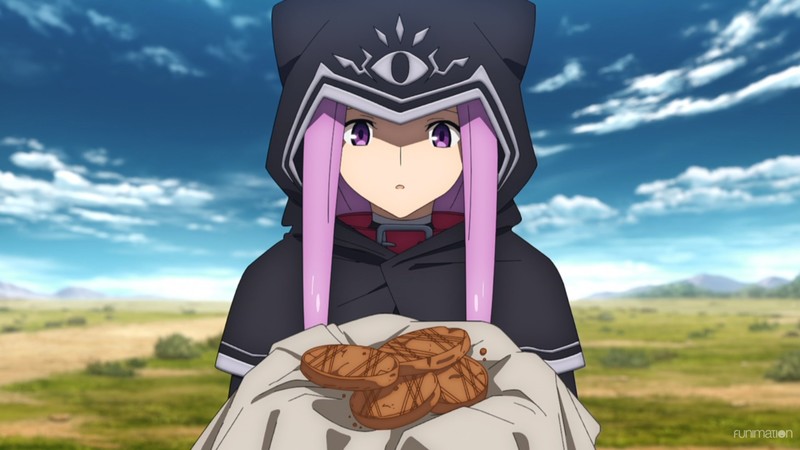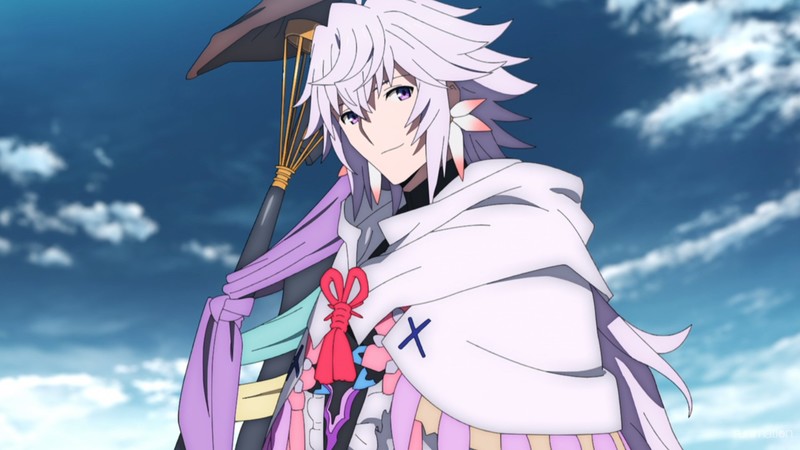The Mythology of Fate/Grand Order: Babylonia — Part 2
by Sylvia Jones,Last time, we traced the roots of Babylonia characters from actual Babylonian mythology. Now, let's dig into the other varieties of myth and legend that Fate/Grand Order pulls from in order to round out its seventh climactic arc. Since I was once a small nerdy child who was a little too obsessed with reading stories about gods, goddesses, monsters, and heroes, some of my research for this feature caused pools of familiarity to well up in my brain. For the most part, however, I found myself learning a lot! And I think now I'm even more fascinated with how Fate chops and rearranges classic characters and narratives into a big messy pile of colorful anime nachos. Even if proper care and thoughtfulness isn't always Fate's chief concern (and boy, sometimes I wish it were), its eagerness to be in conversation with human history is infectious.
GORGON & ANA

In Fate's version, Athena banishes Medusa to the Shapeless Isle, and her two sisters tag along to keep her company. Not content with mere banishment, however, Athena also creates rumors about a monster named Medusa to lure witless heroes to their isle looking for glory. Medusa takes it upon herself to defend her sisters, but the ceaseless onslaught of deluded challengers gradually wears her down until she gives in, physically and mentally, to becoming a monster. Her body turns into the powerful snake-haired and petrification-happy creature from legend, and she devours her sisters, completing her transformation into the Gorgon that Perseus eventually slays.

This is the large and in-charge Gorgon who gets summoned to Babylonia as a stand-in for the primordial goddess Tiamat. In Fate parlance, she's a member of the “extra” class Avenger due to her single-minded concern with extracting revenge for what was done to her. I'm glad there's at least an acknowledgment from the story that Medusa was dealt an extremely shitty hand for her to end up in this situation, but I don't think Babylonia delves into the Medusa legend deep enough to extract any thesis beyond “people suck.” It's a shame, because there's a lot of room for interesting contemporary takes on her legend.
What I do like, however, is the resolution to Gorgon's role in Babylonia. When she gets summoned, a younger version of her also gets summoned, almost like a counterweight. Again, one of the neat quirks of Fate is that Heroic Spirits aren't limited to one version of a character from one point in their life. This small Medusa goes by “Ana” when she meets our heroes, and we can imagine her as Medusa before her banishment or very soon after. She's cognizant of her life's eventual tragedy, and that causes her to withdraw from others, but she still possesses an open-enough mind to see the good in people, alongside the bad. I think she's kind of a one-note character for most of the anime, but her last stand against Gorgon is both clever and heart-wrenching. Perseus famously defeats Medusa by looking at her reflection. Ana, similarly, defeats Gorgon by forcing her to look at herself as she once was.
QUETZALCOATL

As we jump to yet another continent and yet another millennium, we find ourselves looking at the Aztec god of wind, the feathered serpent Quetzalcaotl. While her namesake is the Mesoamerican deity, Babylonia's Quetzalcoatl is an odd bird whose personality and powers are rooted in everything from modern-day Mexico to dinosaurs. In fact, you could probably make a strong argument that the Aztecs wouldn't be too pleased to learn that one of their major deities now speaks with an affectation based on the language of Cortés. But they might have also been really big sakuga fans, so who's to say.
Quetz as a whole is a character of contradictions. The Aztecs practiced human sacrifice, and Babylonia deliberately preys on that preconception before she becomes an ally. Turns out, however, she's just a big fan of lucha libre and pushing people to their limits. Interestingly enough, there are actually some legends that say the mythological Quetzalcoatl wasn't too hot on human sacrifice either. Like Ishtar, Quetzalcoatl was also associated with the planet Venus, which is one reasonable explanation for why she manifested as a woman in Babylonia (although Fate rarely constrains itself by the boundaries of reason when it comes to Servants). She also has a giant pet pterosaur from the genus Quetzalcoatlus for reasons that I hope are obvious, if very silly. This is also why she's in the Rider class. She rides the dinosaur that was named after her.
Quetz might be a very silly character, but I like her a lot, and there aren't too many other characters in Fate with roots in Latin American culture and history. While she might not be the most carefully-considered avatar of representation, she's a lot of fun to watch and listen to.
MERLIN

It simply wouldn't be a Fate article if I didn't get to talk about some Arthurian mythology. If you're anything like me, you watched The Sword in the Stone a lot while growing up, and consequently Merlin's name conjures a mental image of a very old man with a very pointed hat and a very long white beard. Fate's version of Merlin is very much not that. He's a handsome, roguish troublemaker with a questionable moral compass, but if anything, he's more accurate to the primary legends than any Disney movie.
Fate's Merlin is a half-human half-incubus, which is consistent with the origin written by Geoffrey of Monmouth (the guy often regarded as most singularly responsible for kicking off the Arthurian canon). As such, he considers himself separate, though not separated, from the other humans around him. This also means he's a huge asshole who loves messing with people, and especially with the people he's ostensibly there to help. I like to think he handwaves this behavior away with the excuse that his incubus nature feeds on emotions, so of course he possesses a natural predilection towards instigating heightened emotions in people. I also think he just prioritizes his own amusement above most other things. While this might not jive with our popular perception of Merlin as the king's sage adviser, Arthurian canon itself is varied and full of contradictions, so there's little reason to argue that Merlin couldn't have been a jerk. And ultimately, Merlin is on humanity's side, even if he insists on maintaining distance from us.
Part of that distance is a consequence of Merlin's own immortality. Merlin's fate (lower-case f) in Arthurian canon depends on the tale you read. In some stories, Merlin never even meets Arthur, while others describe his downfall at the hands of the Lady of the Lake. Fate incorporates details from a bunch of different tales and has Merlin, having foreseen the downfall of Camelot, escape to the mystical promised land of Avalon. While there, however, he springs a trap (intentionally or not) that imprisons him in a giant tower where he can do nothing but watch the slow passage of human history for the rest of eternity. Since he technically can't die, he technically can't be summoned as a Heroic Spirit, which is why everyone freaks out when he appears in Babylonia. Fate, however, has never written a rule without the intention of breaking it, so Merlin's able to astral-project himself into Uruk because he's just that great a mage. Deal with it.

Merlin's eager to paint himself as a womanizer who only wants to stop King Solomon because the end of humanity would mean the cancellation of his favorite TV show, but in truth, I don't think Merlin ever lets on exactly what's running through his mind. Perhaps, however, we can interpret his Noble Phantasm as a hint. Called “Garden of Avalon,” he heals and enhances his allies by manifesting the stark white tower he calls his home, surrounded by a vast field of beautiful, blooming flowers bathed in sunlight. He might not regret the prison paradise of his fate, but maybe he still revels in the opportunity to share its sights with those close to him.
Those are all the Babylonia characters I have the time, space, and energy to write about for now! I hope you learned something, because I certainly learned a lot during all the research I had to do to put this article together. And in the event that you're a scholar of Mesopotamian/Greek/Mesoamerican/Arthurian/etc. mythology currently waving an itemized list of all the details I got wrong, please send it along. Seriously! I love learning more about stories that have survived multiple centuries and/or millennia, as well as all the ways they've changed alongside different time periods and cultures. I've found my steady descent into Fate hell surprisingly enjoyable because of the part it plays in that literary conversation. Even if it's not always an interesting or helpful contribution, Fate always gives you a chance to find something new.
Steve watches too much anime and has somehow stumbled into a way to do so professionally. You can find him on ANN writing weekly streaming reviews and making bad jokes on This Week In Anime. For worse jokes, please follow him on Twitter at @vestenet.
discuss this in the forum (10 posts) |
back to The Mythology of Fate/Grand Order: Babylonia — Part 1
Feature homepage / archives